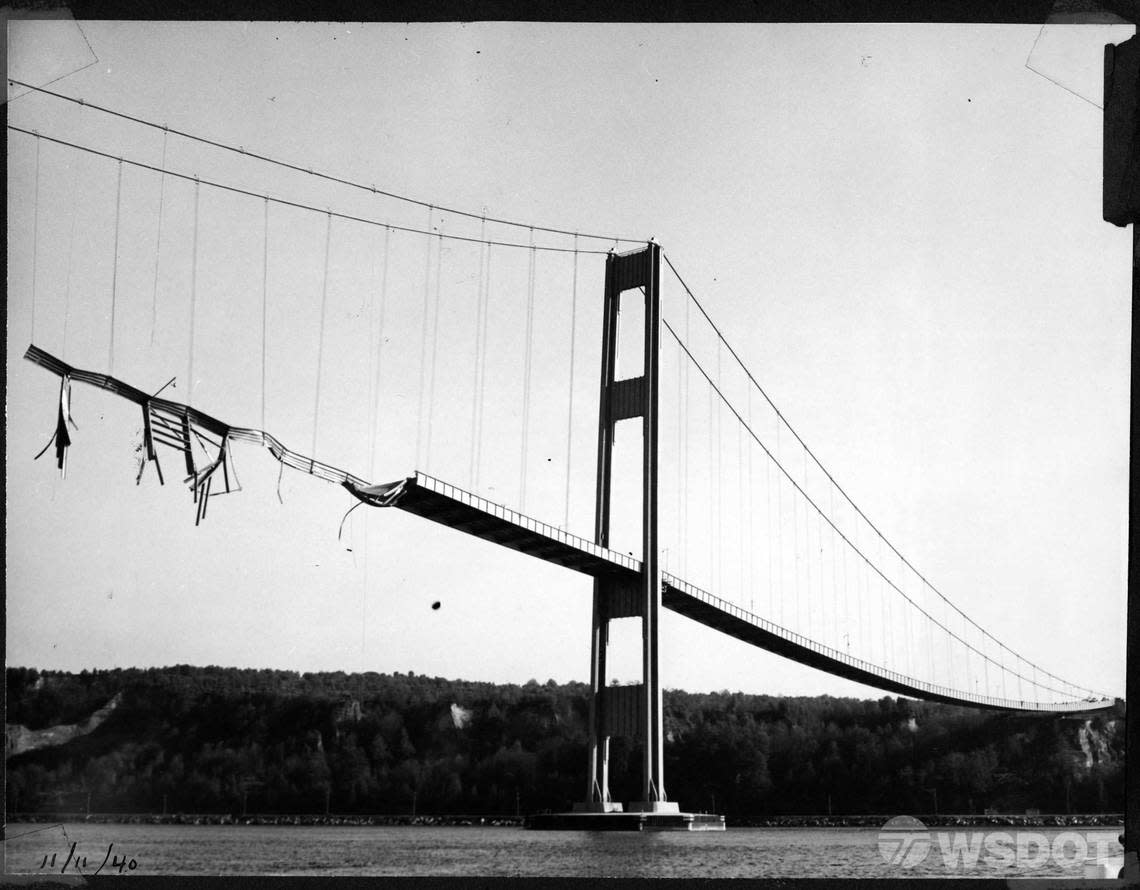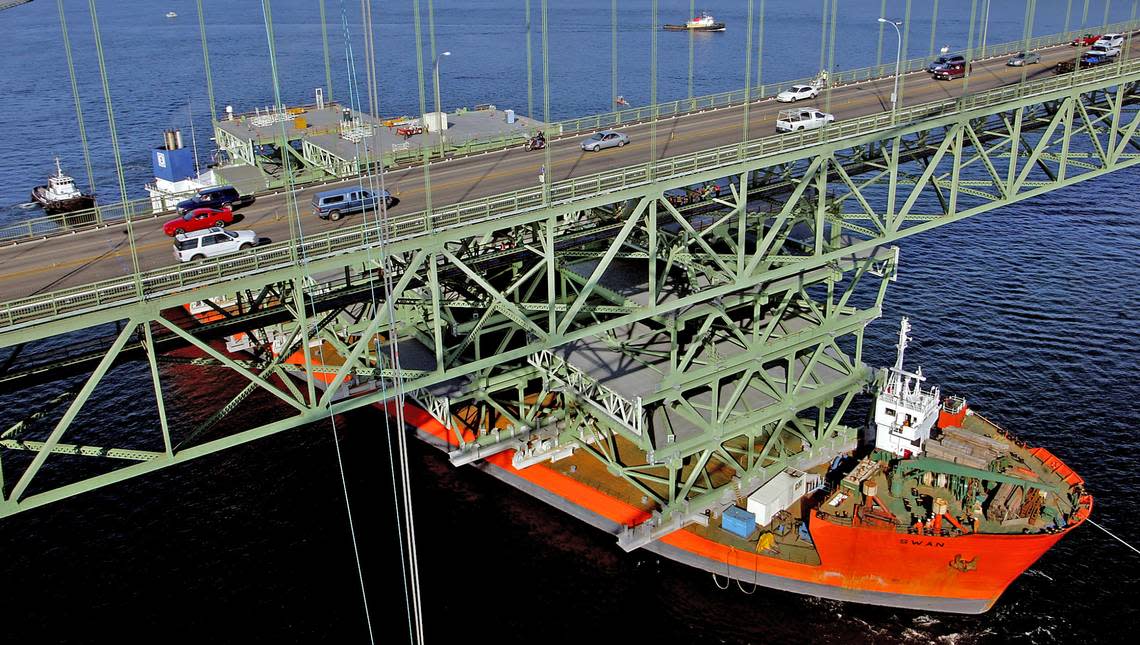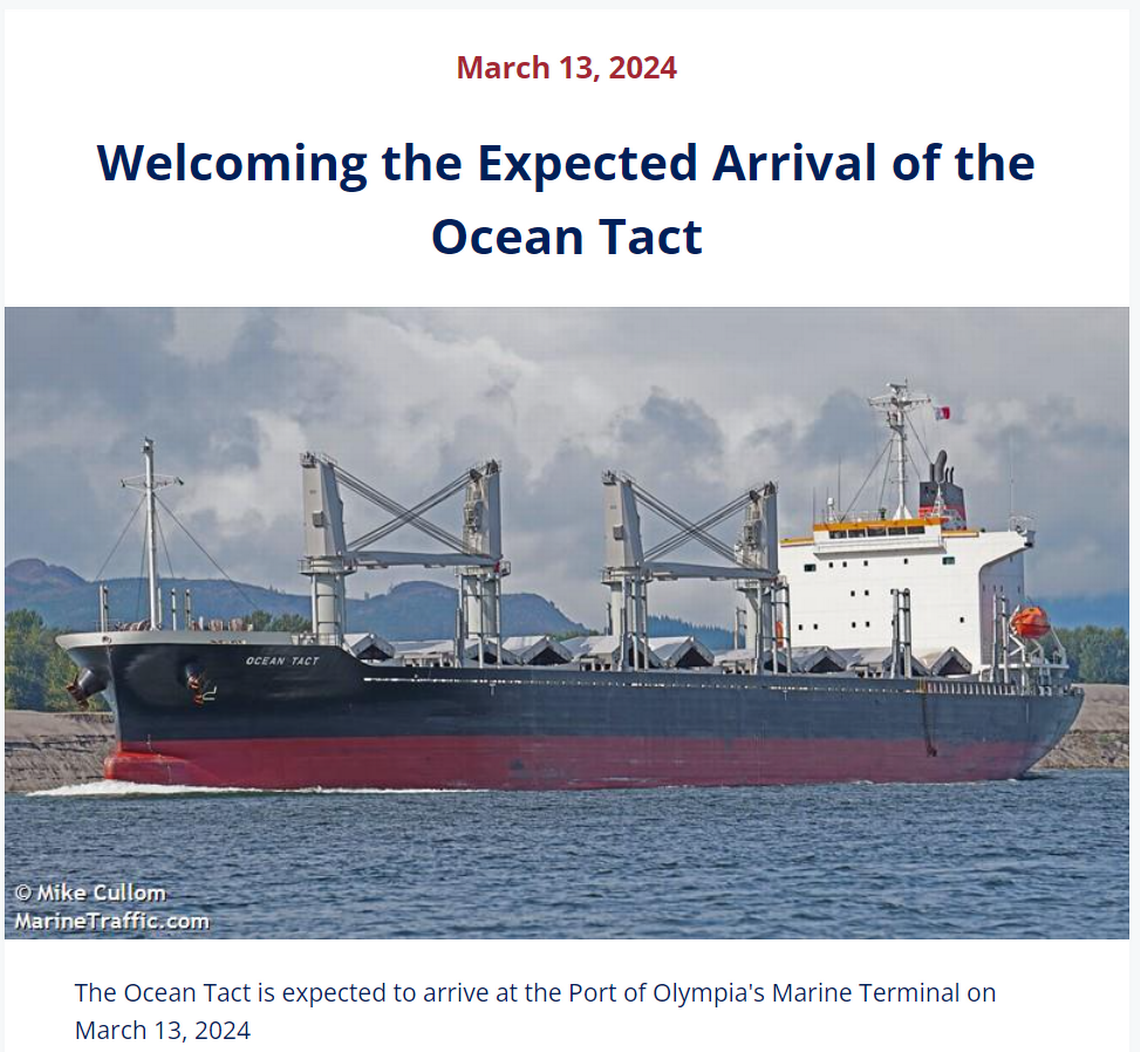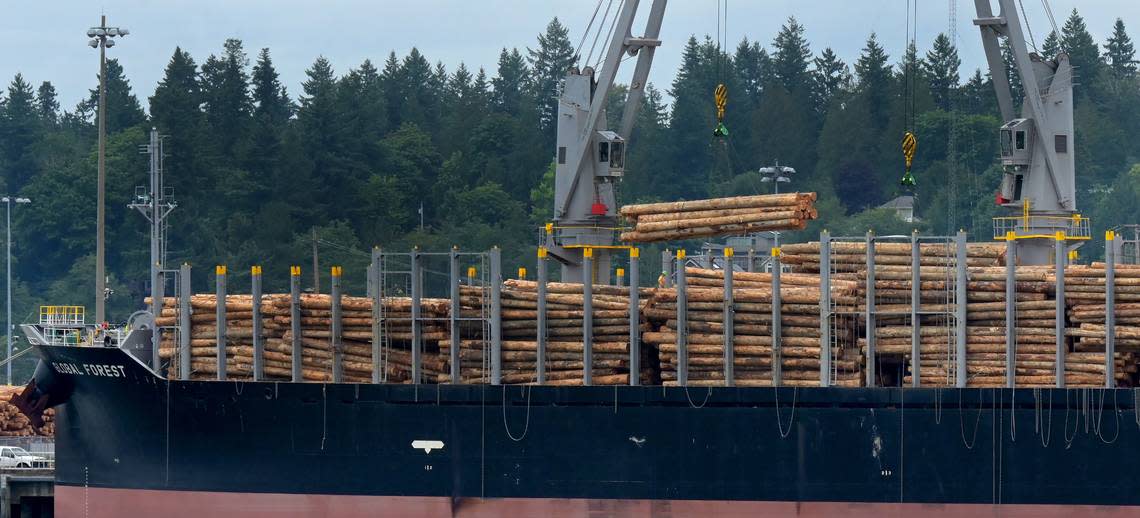Could Baltimore bridge disaster happen to Tacoma Narrows spans? Here’s what we know
Baltimore has now joined Tacoma as a city inextricably linked with monumental bridge collapses. But the demise of the first Tacoma Narrows Bridge less than a year after it opened in 1940 came during a wind storm and was due to its poor design. Tuesday’s collapse of the Francis Scott Key Bridge was the result of a ship strike.
Hours after the Key collapse, U.S. Transportation Secretary Pete Buttigieg said that he knew of no bridge in the United States “that has been constructed to withstand a direct impact from a vessel of this size,” according to the Wall Street Journal.
The accident raises the question: Could the current Tacoma Narrows Bridge fail after a ship strike?

Suspension and truss bridges
The second Narrows span was built in 1950 and the third was opened in 2007. Both are suspension bridges. Their bridge decks are held aloft by cables that are in turn supported by the bridges’ towers and their anchors set at either end. Other well known West Coast suspension bridges include the Golden Gate in San Francisco and the Lions Gate in Vancouver, B.C.
The Key Bridge is a truss bridge, a superstructure that rests on its supports. The 1966 Astoria-Megler Bridge built near the mouth of the Columbia River between Washington and Oregon is the longest truss bridge in the United States. It reaches its highest point close to Astoria, Oregon, where it crosses over the commercial shipping channel.
In 1980, 35 people were killed when a freighter ship, its crew blinded by fog, crashed into Florida’s Sunshine Skyway Bridge. That truss bridge was eventually replaced by a cable-stayed bridge, similar to the state Route 509 bridge that carries traffic into downtown Tacoma.
Tacoma Narrows Bridge
The state Department of Transportation (WSDOT), which maintains the Tacoma Narrows Bridge, said its crews review, train and follow safety protocols every day.
“We also work closely with first responders and emergency managers (including the Coast Guard) to train for and respond to any type of emergency that affects the transportation system,” WSDOT said in a statement to The News Tribune on Wednesday.
The tower legs for each span of the Narrows Bridge are protected by concrete piers sunk deep into the channel’s seabed. The two sets of towers are in line with each other, preventing the need for ships to change course between spans. Pier lights are set on each leg.
The bridge decks are roughly 200 feet above the water, allowing marine traffic to safely pass under them. Clearance lights are installed underneath each span.
The bridge’s fog horns are designed to be heard from two miles away. All of safety items are tested weekly to ensure they are working properly, according to WSDOT.
There is, of course, always the factor of human error. In 2006, a ship loaded with deck sections for the newest Narrows span collided with the old span. Bridge builders thought the ship would glide under the old span with 36 feet to spare. Instead, temporary scaffolding on top of the deck sections hit the underside of the bridge and toppled over.
No one was hurt, and no damage was done to the bridge or the new bridge decks that were shipped from their manufacturer in South Korea.

Bigger ships
Over the past decades, the size of commercial ships calling at U.S. ports has greatly increased. The massive container ships that enter Puget Sound from their ocean journeys turn in Commencement Bay and head to the Port of Tacoma before ever reaching the Narrows.
“We do not have ocean-going container ships that travel underneath bridges in Washington state to access our main container terminals in Seattle and Tacoma, or the Ports of Everett and Bellingham further up the sound,” said Eric ffitch, executive director of the Washington Public Ports Association.
The ultra-large container vessels that call at Tacoma and Seattle can range as high as 15,000 twenty-foot equivalent units (TEUs), according to Northwest Seaport Alliance spokesperson Melanie Stambaugh. A TEU is the standard unit of measurement for container ships. The typical 40-foot-long containers stacked at the Port of Tacoma for shipping on boats, trains and trucks each equal two TEUs.
The Dali, the ship that struck the Key Bridge, is 984 feet long and has a capacity of 10,000 TEUs.
Olympia ship traffic
Smaller, breakbulk cargo ships that primarily carry timber and bulk goods call at the Port of Olympia. They have to transit through the Narrows and under the Tacoma Narrows Bridge.
Olympia sees about 24 large commercial ships a year calling at its port, according to port spokesperson Camille St. Onge. They range from 400 to 700 feet long.
On March 13, the Port of Olympia’s website welcomed the arrival of the Panamanian flagged Ocean Tact, a bulk carrier. The ship is 590 feet long and 98 feet wide, according to website marinetraffic.com. According to the website, the Ocean Tact departed Olympia on March 19 and on Wednesday was passing through the Aleutian Islands at 13 knots on its way to Japan.

Pilots
At sea, commercial ships are navigated by their crews. But once they enter and while they are in the waters of Puget Sound they are boarded by local pilots who are trained to help the ships navigate through the sound’s many waterways and ports.
According to the pilots’ professional organization, Puget Sound Pilots, they have conducted more than 200,000 sailings over the last 25 years without a major incident.

Initial findings from the Dali, which also had a pilot on board, point toward mechanical issues rather than a navigation problem as the cause of the accident. The ship’s lights were seen going off and and on and the crew issued a mayday distress call, warning of a possible collision with the bridge.
Emergency closure
Police in Baltimore, with just 90 seconds to spare, successfully shut down traffic on the Key Bridge before it collapsed Tuesday. The six lives that were apparently lost in the collapse were those of a construction crew unable to evacuate the structure in time.
WSDOT said that should there be a need to close either or both spans of the Tacoma Narrows Bridge, it would initially block the roadways with trucks. A closure could occur during dangerous weather, fuel truck fire, structural failure, marine emergency or other reasons.
The agency would coordinate with the Washington State Patrol and WSDOT’s Traffic Management Center. The center is able to view the bridge in real time with cameras.
“Should there be a longer-term closure, WSDOT has the ability to reconfigure either bridge to accommodate two-way traffic,” it said.
Bridge maintenance
While neither the famous Tacoma bridge collapse nor the Baltimore disaster were apparently associated with bridge maintenance, WSDOT said Wednesday it’s a major concern for the agency. Its bridges are regularly inspected. Those results are reported to the Federal Highway Administration.
“Anytime we have a bridge strike — more commonly an over height vehicle — our specialized bridge crews go out and inspect the bridge,” WSDOT said. In 2013, a truck struck carrying an oversize load struck the Interstate 5 truss bridge over the Skagit River, collapsing it and plunging eight people and their vehicles into the river. Fortunately, all survived.
WSDOT said some of its bridges that span channels navigated by large vessels have fenders or piers in place to help stop ships from striking them.
“Limited preservation and maintenance funding, however, restricts our ability to provide fenders or piers at all bridge locations,” the agency said. “While details are still emerging, it’s important to note that while a robust pier protection system in place would improve any bridge’s resistance to minor collisions with marine vessels, the Baltimore bridge collapse was a result of a catastrophic strike by a large cargo vessel moving at a high speed.”
The City of Tacoma is currently repairing a bridge over the Hylebos Waterway after one of its fenders was struck by a barge in 2023.
WSDOT said it’s following developments in the Baltimore tragedy and will apply any lessons learned to its protocols and procedures.
